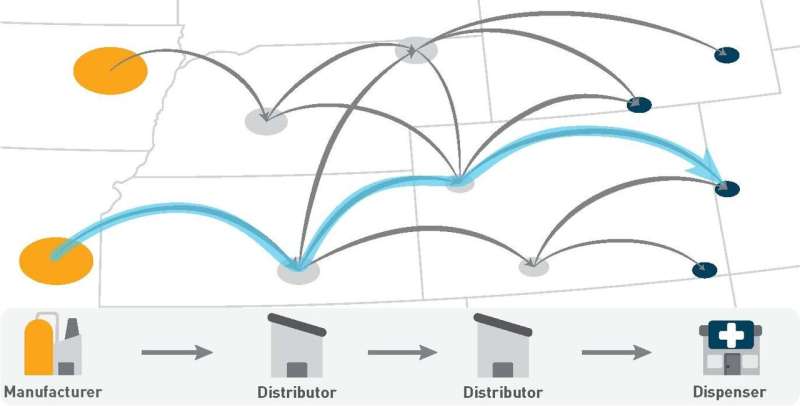This article has been reviewed according to Science X's editorial process and policies. Editors have highlighted the following attributes while ensuring the content's credibility:
fact-checked
peer-reviewed publication
trusted source
proofread
Researchers propose a navigation system to tackle medication supply bottlenecks

Supply bottlenecks for medications present major challenges to health care systems the world over. In Switzerland, for instance, just under 1,000 drugs that are covered by statutory health insurance are currently unobtainable.
Currently, the main strategy for tackling such bottlenecks has been diversification: if it looks like supplies of a particular drug will run low, wholesalers try to procure alternative products via other manufacturers and supply chains in the market. But all too often, this proves difficult because the shortage of raw materials for medications means that there are no alternatives available.
ETH researchers have now authored a study, published in the journal Science Advances, that points out a different path.
Even if multiple wholesalers are affected by a supply bottleneck for a particular drug, there is usually enough of that drug available within the overall medication distribution system. As long as the wholesalers reroute scarce medications as flexibly as possible along existing supply chains, they can stave off and ease shortages. This calls for fully digital distribution systems that allow supervisory authorities and wholesalers to monitor inventories in real time and see the location of specific shipments.
"Flexible, digital supply chains lead to more efficient distribution of scarce goods. It's a way of combating supply shortages without necessarily having to increase production immediately," says Frank Schweitzer, Professor of Systems Design at ETH Zurich. Together with the scientists in his research group, he developed a model that measures the flexibility of drug distribution systems in real time with a view to ascertaining their resilience. This model can help supervisory authorities to detect supply shortages early on and to enhance the resilience of distribution systems.
Flexible supply chains
"You can picture the distribution network for a medication like a road network with various junctions," says Luca Verginer, one of the study's co-authors. Buyers like pharmacies and hospitals tend to be connected to manufacturers through several wholesalers, which store their stock at distribution centers. It would be possible for these distribution hubs to reroute medication shipments as well.
In this scenario, should there be a bottleneck in production or distribution, wholesalers can get a scarce medication or a suitable substitute to buyers via an alternative route—similar to when a car's navigation system suggests a new route when there's a traffic jam ahead.
This would lead to better distribution of idle stocks of scarce medications. Wholesalers also benefit from not having to go to the trouble of establishing new business relationships with additional manufacturers and distributors; they're simply using existing supply chains more efficiently. Another important source of flexibility in the distribution system is that wholesalers have access to alternative products that have the same active ingredient as the medications that are in short supply.
Extensive opiate data from the US
To develop their model, the researchers examined the entire distribution system for opiates in the U.S. for the years 2006 to 2014. The required logistics data was obtained from the U.S. Drug Enforcement Administration (DEA) and was released as part of a legal action against the drug company Purdue Pharma. This data contains details relating to more than 40 billion distribution routes between manufacturers, wholesalers and buyers.
"This dataset offers an unprecedented overview of the nationwide distribution of a high-demand drug which, over the observation period, was repeatedly in short supply," Verginer says. The researchers used the data to assess how well different supply chains were able to maintain the flow of goods by tapping sources of alternatives in response to a bottleneck but still using existing distribution routes.
KPI for flexibility and resilience
The result of this assessment is a flexibility KPI that measures the potential of using alternative distribution routes to maintain supply of drugs. The higher the KPI value, the more adaptable and resilient a distribution system is in dealing with bottlenecks. For instance, the researchers' analysis revealed that when the U.S. distribution system for opiates displayed an extremely high level of flexibility, there were fewer supply shortages.
But the researchers also showed that flexibility comes at a cost. "Flexible supply chains tend to be less direct because they involve more intermediaries. This slows down distribution and drives up costs," Schweitzer says. "There's a conflict of objectives between a distribution system's flexibility and resilience and its economic efficiency." The ETH researchers' new model can help supervisory authorities to better understand this conflict.
Tool for supervisory authorities
Although the model was developed using data on opiate distribution in the U.S., Schweitzer stresses that it can also be applied to other distribution systems.
"Our model would, for example, also work with the extensive product data collected by the European Medicines Verification Organization and stored in the European Medicines Verification System." European supervisory authorities would then be able to better monitor supply chains for high-demand medications in Europe, and intervene early on to boost these chains' flexibility and resilience.
More information: Ambra Amico et al, Adapting to disruptions: Managing supply chain resilience through product rerouting, Science Advances (2024). DOI: 10.1126/sciadv.adj1194




















